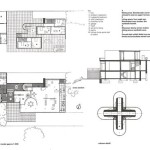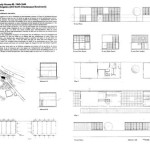South Facing House Plans As Per Vastu
Vastu Shastra, the ancient Indian science of architecture, emphasizes the importance of aligning a building's design with the natural elements. It aims to create harmonious and prosperous living spaces by considering directions, magnetic fields, and the flow of energy. While traditionally, north or east-facing houses are often preferred, south-facing houses can also be incredibly auspicious and beneficial when designed according to Vastu principles. This article delves into the specific guidelines and considerations for creating south-facing house plans that adhere to Vastu Shastra.
The misconception that south-facing houses are universally inauspicious stems from a misunderstanding of Vastu principles. Vastu Shastra does not categorically condemn any direction. Instead, it focuses on correctly positioning various elements within the house to maximize positive energy flow and minimize negative influences. A poorly designed house, regardless of its facing direction, can negatively impact its occupants. The key lies in adhering to the guidelines applicable to the specific orientation.
One of the primary considerations for a south-facing house is the placement of the main entrance. According to Vastu, the main entrance should be located in a positive zone on the southern wall. The selection of the precise location requires careful consideration of the 32 zones on each side of the house, which is best determined by a qualified Vastu consultant. Deviations from the prescribed locations can bring negative energy and difficulties into the lives of the residents. Avoid placing the main entrance in the southwest corner, as this is generally considered inauspicious.
The slope of the land is another crucial factor. Ideally, the land should slope from north to south or from east to west. This allows for the natural flow of water and energy towards the north and east, which are considered auspicious directions in Vastu. If the land slopes in the opposite direction, remedies can be implemented to redirect the energy flow, such as constructing retaining walls or strategically placing plants.
Ensuring sufficient open space in the north and east is also essential. More open space in these directions allows for ample sunlight and ventilation, which are vital for a healthy living environment. This also facilitates the entry of positive energies into the house. Avoid constructing high walls or structures that block sunlight from entering the north and east sides of the house.
Optimal Room Placement in South-Facing Houses
Room placement plays a critical role in harnessing positive energy in a south-facing house. Certain rooms are more suited to particular directions, and adhering to these guidelines can significantly enhance the overall well-being of the occupants.
The kitchen, ideally, should be located in the southeast corner of the house. This ensures that the person cooking faces east, which is considered highly auspicious. Avoid placing the kitchen in the northeast corner, as this can lead to financial instability and health problems. The gas stove should also be oriented such that the cook faces east while cooking.
Bedrooms are ideally placed in the southwest corner of the house. This ensures that the occupants sleep with their heads pointing south, which is considered the most restful and beneficial direction. Avoid placing bedrooms in the northeast corner, as this can disrupt sleep patterns and create restlessness. The master bedroom should be the largest bedroom in the house and located in the southwest.
The living room can be located in the north or east side of the house. This allows for ample natural light and ventilation, creating a welcoming and positive space for socializing and relaxation. Avoid cluttering the living room, as this can obstruct the flow of energy. Furniture should be arranged in a way that facilitates conversation and interaction.
The pooja room, or prayer room, should be located in the northeast corner of the house. This is considered the most sacred and auspicious direction. Ensure the pooja room is clean and well-maintained, and avoid using it for any other purpose. Idols or images of deities should face east.
Toilets and bathrooms should ideally be located in the northwest or southeast corners of the house. Avoid placing them in the northeast or southwest corners, as this can negatively impact health and prosperity. Ensure proper ventilation in toilets and bathrooms to prevent the build-up of negative energy.
Addressing Common Vastu Issues in South-Facing Homes
Certain inherent challenges arise when designing a south-facing house according to Vastu. Understanding these issues and addressing them proactively is crucial for mitigating potential negative effects.
One common issue is the intensity of the south-facing sun, especially during the summer months. To counteract this, consider using thick curtains or blinds to block out excessive sunlight. Planting trees or shrubs along the south side of the house can also provide natural shade and cooling. Installing awnings or pergolas can further reduce heat gain.
Another challenge is the potential for negative energy to enter the house through the south-facing entrance. To mitigate this, ensure that the entrance is well-lit and properly maintained. Placing auspicious symbols, such as the Om symbol or Swastika, above the entrance can also help to ward off negative energy. Regularly cleaning the entrance area is essential.
A common problem is the incorrect placement of the septic tank. According to Vastu, the septic tank should never be located in the northeast corner of the house. This can lead to serious health problems and financial losses. The ideal location for the septic tank is in the northwest or west side of the house.
Avoid having a water body, such as a well or swimming pool, in the south or southwest corner of the house. This can lead to financial instability and relationship problems. If a water body is unavoidable, ensure that it is properly aligned and maintained according to Vastu principles.
Proper boundary walls are essential for a south-facing house. The south and west walls should be thicker and higher than the north and east walls. This helps to protect the house from negative energy and provides stability. Avoid having any openings or gaps in the south or west walls.
Enhancing Positive Energy in South-Facing Houses
Beyond addressing potential issues, specific steps can be taken to actively enhance positive energy within a south-facing house. These practices contribute to a more harmonious and prosperous living environment.
Color selection plays a significant role in Vastu. For a south-facing house, using colors like red, orange, and yellow on the south walls can be beneficial. These colors represent fire, which is associated with the south direction. Avoid using dark colors like black or gray on the south walls, as they can attract negative energy. Light and bright colors are suitable for the north and east sides of the house.
Placing specific plants in certain directions can also enhance positive energy. Tulsi plant, considered sacred in Hinduism, should be placed in the northeast corner of the house. Money plants are best placed in the southeast corner. Avoid placing thorny plants, such as cacti, inside the house, as they can generate negative energy.
Regularly decluttering the house is essential for maintaining a positive energy flow. Get rid of any broken or unused items, as they can block the flow of energy. Keep the house clean and well-ventilated. A clutter-free environment promotes clarity and positivity.
Using crystals, such as amethyst and clear quartz, can help to purify the energy in the house. Place these crystals in different corners of the house to create a harmonious and balanced environment. Regularly cleanse the crystals to remove any negative energy they may have absorbed.
Playing soothing music or chanting mantras can also help to create a positive atmosphere in the house. This can help to relax the mind and promote a sense of well-being. Avoid playing loud or aggressive music, as it can disrupt the energy flow.
Performing regular havans or pujas (religious rituals) can purify the house and invite positive energy. These rituals involve offering prayers and oblations to deities. Consulting a qualified priest or religious expert can help to ensure that the rituals are performed correctly according to Vastu principles.
In conclusion, designing a south-facing house according to Vastu principles requires careful planning and attention to detail. By following the guidelines outlined in this article, homeowners can create a harmonious and prosperous living environment that aligns with the natural energies of the earth.

South Facing House Vastu Ideas That You Can Use For Your Home

This Is South Facing House Plan As Per Vastu Shastra The Land Area Of 47 3 N Plans Construction
Wonderful 2bhk South Facing House Plans As Per Vastu Shastra

110 South Facing House Plans As Per Vastu Shastra Principles By Sethu Pathi Ebook Barnes Noble

Two Bedroom Vastu Home Plan For South Face Plot Facing House N Plans 20x30

South Facing House Plans Vastu Plan For

South Facing House Plans As Per Vastu Shastra By Pathi Sethu Like New U 9781702116534

110 South Facing Home Plans As Per Vastu Shastra Ebook By A S Sethu Pathi Epub Book Rakuten Kobo United States

South Facing Vastu House Plan

Beautiful South Facing House Plans As Per Vastu Shastra Buy By A S Sethupathi At Low In Flipkart Com








